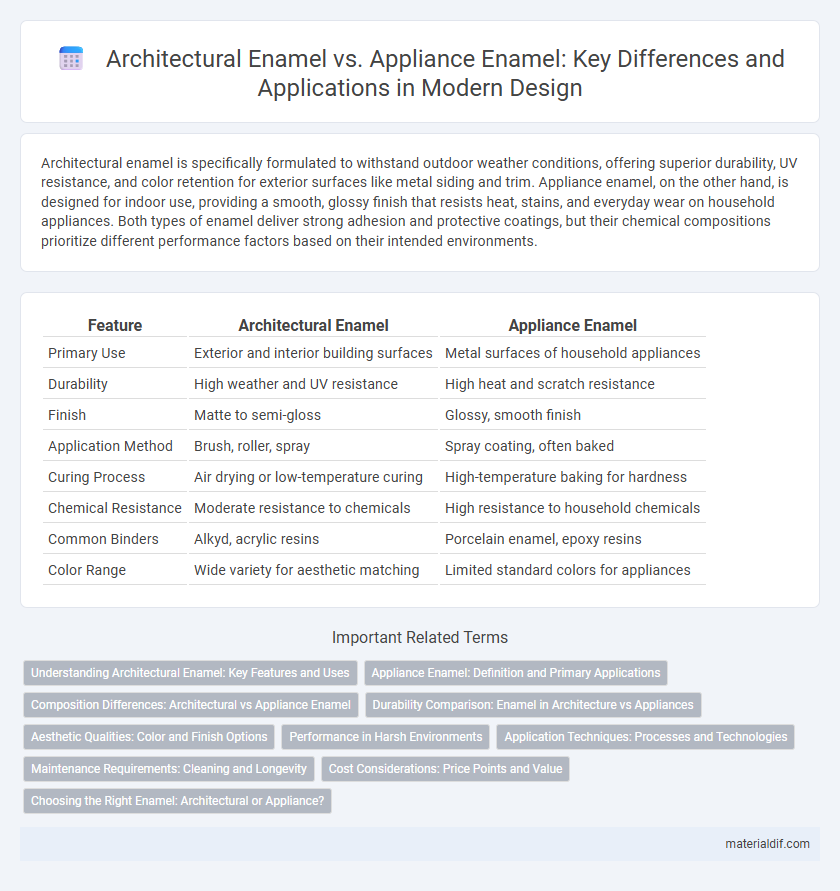Architectural enamel is specifically formulated to withstand outdoor weather conditions, offering superior durability, UV resistance, and color retention for exterior surfaces like metal siding and trim. Appliance enamel, on the other hand, is designed for indoor use, providing a smooth, glossy finish that resists heat, stains, and everyday wear on household appliances. Both types of enamel deliver strong adhesion and protective coatings, but their chemical compositions prioritize different performance factors based on their intended environments.
Table of Comparison
| Feature | Architectural Enamel | Appliance Enamel |
|---|---|---|
| Primary Use | Exterior and interior building surfaces | Metal surfaces of household appliances |
| Durability | High weather and UV resistance | High heat and scratch resistance |
| Finish | Matte to semi-gloss | Glossy, smooth finish |
| Application Method | Brush, roller, spray | Spray coating, often baked |
| Curing Process | Air drying or low-temperature curing | High-temperature baking for hardness |
| Chemical Resistance | Moderate resistance to chemicals | High resistance to household chemicals |
| Common Binders | Alkyd, acrylic resins | Porcelain enamel, epoxy resins |
| Color Range | Wide variety for aesthetic matching | Limited standard colors for appliances |
Understanding Architectural Enamel: Key Features and Uses
Architectural enamel is a durable coating specifically formulated for exterior and interior building surfaces, offering excellent weather resistance, UV protection, and vibrant color retention. It is designed to withstand harsh environmental conditions such as moisture, temperature fluctuations, and pollutants, making it ideal for metal, wood, and masonry applications. Unlike appliance enamel, which emphasizes heat resistance and smooth finishes for household items, architectural enamel prioritizes longevity and structural protection in construction environments.
Appliance Enamel: Definition and Primary Applications
Appliance enamel is a specialized coating applied to metal surfaces, primarily designed for household appliances such as refrigerators, ovens, and washing machines. Its formulation emphasizes durability, heat resistance, and smooth finish to withstand daily use and cleaning. This enamel provides corrosion protection and enhances the aesthetic appeal of appliances, ensuring long-lasting performance under operational stresses.
Composition Differences: Architectural vs Appliance Enamel
Architectural enamel typically contains weather-resistant resins and UV stabilizers designed to withstand outdoor exposure, while appliance enamel incorporates higher levels of epoxy or polyester resins for enhanced durability and chemical resistance in indoor environments. The pigment composition in architectural enamel is formulated to resist fading and chalking under sunlight, whereas appliance enamel pigments prioritize scratch resistance and surface hardness. These compositional differences optimize architectural enamel for longevity and environmental endurance, contrasting with appliance enamel's focus on robust finish and ease of cleaning.
Durability Comparison: Enamel in Architecture vs Appliances
Architectural enamel is formulated with enhanced UV resistance and weatherproof properties, ensuring superior durability against outdoor elements such as rain, wind, and temperature fluctuations. Appliance enamel prioritizes heat resistance and impact strength to withstand frequent use and high temperatures inside household appliances. The durability of architectural enamel excels in long-term outdoor applications, while appliance enamel is optimized for mechanical stress and thermal cycling in indoor environments.
Aesthetic Qualities: Color and Finish Options
Architectural enamel offers a wide range of color palettes and customizable finish options, including matte, gloss, and satin, designed to enhance building exteriors with durability against weather elements. Appliance enamel prioritizes sleek, smooth finishes such as high-gloss or semi-gloss to provide a polished look while ensuring resistance to heat and stains. Both types maintain vibrant color retention, but architectural enamel emphasizes UV stability for outdoor applications, whereas appliance enamel focuses on easy cleaning and scratch resistance for indoor use.
Performance in Harsh Environments
Architectural enamel exhibits superior UV resistance and weatherproofing, making it ideal for prolonged outdoor exposure and harsh environmental conditions. Appliance enamel prioritizes chemical resistance and durability against daily wear, ensuring longevity in indoor settings prone to frequent cleaning and temperature fluctuations. Both enamels offer robust performance, but architectural enamel excels in maintaining color stability and structural integrity under extreme weather stress.
Application Techniques: Processes and Technologies
Architectural enamel is applied using advanced spray techniques and electrostatic painting to ensure uniform coverage and durability on large surfaces like facades and metal frames. Appliance enamel utilizes powder coating and high-temperature curing processes that provide a hard, resistant finish ideal for household appliances exposed to heat and frequent cleaning. Both enamels rely on precise temperature control and surface preparation technologies to optimize adhesion and longevity in their respective applications.
Maintenance Requirements: Cleaning and Longevity
Architectural enamel requires periodic cleaning with mild detergents to maintain its finish and typically offers higher resistance to UV rays, ensuring longer-lasting color retention on exterior surfaces. Appliance enamel, designed for indoor use, demands gentle cleaning to prevent chipping or scratching but provides excellent durability against household stains and thermal stress. Both types benefit from proper maintenance, with architectural enamel favoring weather-resistant properties and appliance enamel tailored for everyday kitchen conditions.
Cost Considerations: Price Points and Value
Architectural enamel typically commands higher price points due to its enhanced durability, weather resistance, and aesthetic variety, making it a preferred choice for exterior applications. Appliance enamel offers a more cost-effective solution, optimized for indoor use with smooth finishes and excellent resistance to stains and scratches, providing significant value in household or commercial appliances. When evaluating cost considerations, the decision hinges on balancing upfront price with long-term performance and maintenance needs relative to the intended application environment.
Choosing the Right Enamel: Architectural or Appliance?
Architectural enamel offers superior durability and weather resistance, making it ideal for exterior surfaces exposed to harsh environmental conditions. Appliance enamel provides a smooth, glossy finish with excellent heat and stain resistance, perfect for indoor applications such as kitchen appliances. Selecting the right enamel depends on the specific use case, with architectural enamel suited for structural elements and appliance enamel optimized for household devices.
Architectural enamel vs Appliance enamel Infographic

 materialdif.com
materialdif.com